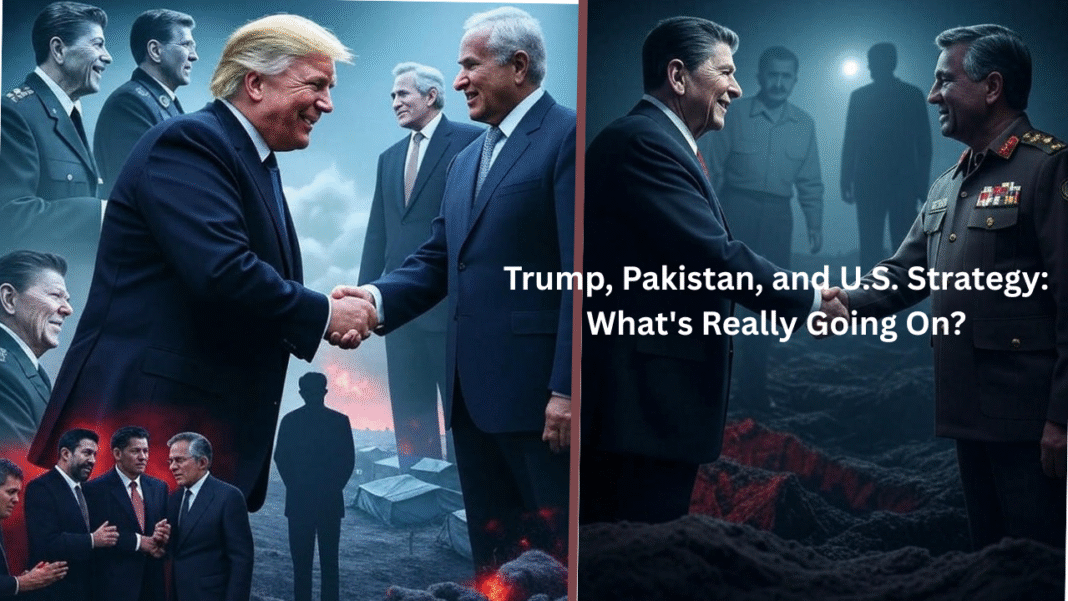In India, there are many policy-makers, policy commentators, and think tank experts who are all asking one major question: Why has Donald Trump—and America in general—suddenly rediscovered its love for Pakistan?
I’ve touched on this topic earlier on The Chanakya Dialogues and on television, but today, I want to explore it in detail, so you understand the logic, history, and possible future behind this pattern.
Frankly, I believe people like Prime Minister Modi, Dr. S. Jaishankar, and NSA Ajit Doval are literally enjoying this moment quietly. They know exactly what music the U.S. is playing—and what game is really going on. But they are choosing silence. So, let’s break it down ourselves.
What Did Trump Say?
After Operation Sindoor, Trump made a statement:
“I didn’t want India and Pakistan to go to war. I used trade as leverage. They were both nuclear powers, and they were about to attack each other. I prevented a nuclear war.”
Of course, there was never going to be a nuclear war—but Trump being Trump, he took the spotlight.
Many claimed that he’s just being brash, that he speaks without thinking.
But I don’t agree with this view. Trump knows exactly what he’s saying. He may act foolish, but he’s strategically shrewd.
And this time, what he said caught Indians off guard, while Pakistanis were celebrating.
Why Was Pakistan Happy?
Trump didn’t exactly praise Pakistan directly.
But he did something even more significant—he placed India and Pakistan on the same level. That’s what thrilled the Pakistanis.
For years, India has fought hard to remove itself from the “Indo-Pak” hyphenation.
From “Indo-Pak,” the narrative moved to “Af-Pak”—India saying, don’t mix us with Pakistan. India has made it clear: we are as different as chalk and cheese.
Yet here comes Trump, again bringing up “India-Pakistan” together, and adding this:
“Pakistan has got great leadership. Some people may not like what I say, but it’s the truth.”
Then he adds:
“Pakistan makes some really marvellous, some really great products.”
Even Pakistanis were confused—“What exactly do we make that Trump is praising?”
But the “old rice” in Pakistan—the senior, experienced analysts—they know what’s going on. They just can’t say it publicly.
The U.S. Playbook: A Pattern Repeats
Let me take you back.
1982: Reagan Praises Dictator Zia-ul-Haq
There was a White House dinner in honor of General Zia-ul-Haq and his wife.
Reagan showered him with praise:
“When you smile, the sun rises. When you’re upset, the sun sets.”
Let’s remember: Zia-ul-Haq wasn’t elected—he was a military dictator.
He hanged Pakistan’s elected PM Zulfiqar Ali Bhutto in what’s still called a judicial murder.
Zia was criticized globally—until 1979, when the Soviet Union invaded Afghanistan.
America saw its chance to bleed the USSR, just like the Viet Cong had humiliated the U.S. in Vietnam—with Soviet help. Now, the U.S. wanted payback.
And who would be the broker for the war?
Pakistan—specifically, Zia-ul-Haq.
Zia became America’s go-to guy.
Billions in aid followed.
In return, Zia radicalized Pakistan:
- Introduced Sharia courts
- Army officers were judged by beard length
- The liberal Pakistani army became Islamized
Zia changed the military’s motto to:
“Iman, Taqwa, Jihad fi Sabilillah”
That era poisoned Pakistan permanently—and the country still suffers from it today.
Post-9/11: The Same Story Repeats
After 9/11, 2001, General Musharraf gets the same treatment.
President George Bush calls Pakistan’s president and says:
“Help us—or we will bo/mb you back to the Stone Age.”
Again, Pakistan helps.
Again, billions in aid flow in.
Again, the cycle of terrorism, radicalization, and internal destruction begins.
Eventually, Osama bin Laden is killed in Abbottabad—deep inside Pakistan.
Today, Pakistan claims:
“We lost 80,000 people. We are victims too!”
But let’s be clear: Pakistan is not a victim—it is the mother of terrorism.
What Happens When America Praises Pakistan?
Let me put it bluntly:
Every time America praises Pakistan, blood is shed in Pakistan.
It happened with Zia-ul-Haq.
America praised him, and Pakistan radicalized.
It happened with Pervez Musharraf.
America praised him, and Pakistan faced endless terror.
Now, it’s happening with General Asim Munir.
He’s being praised. He’s being invited to U.S. military parades as Guest of Honour.
This isn’t the first time a Pakistani general was treated like royalty.
It’s happened before. And each time—it ended in disaster for Pakistan.
The young generation in Pakistan may not understand this.
But the “old rice” does—they know what’s coming, and they’re scared.
What’s the Real Game? Iran.
This time, I believe the target is Iran.
Pakistan is once again being primed as a proxy.
Just like the Cold War.
Just like post-9/11.
Pakistan is being groomed for something very dangerous—again.
What Does India Know?
As I said at the beginning—Modi, Doval, Jaishankar—they know all this.
They’ve read this script before.
And that’s why they’re quietly enjoying the show.
India is not reacting loudly—because it knows:
“Whenever the U.S. embraces Pakistan, it is not out of love—it is out of strategy.”
And that strategy never ends well for Pakistan.
Final Thoughts
So, the next time you see Trump or a U.S. general praising Pakistan, don’t get emotional—understand the play.
History doesn’t just rhyme.
In this case, it’s playing the same song on repeat.
And while the music plays, some are dancing…
But others know—there’s a storm coming.




